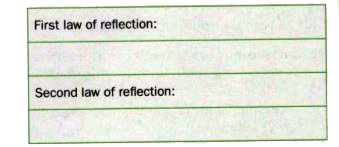Irregular reflection _______ laws of reflection.
Step-by-Step Solution:
1. Understanding Reflection: Reflection refers to the bouncing back of light rays when they hit a surface. There are two types of reflection: regular (or specular) reflection and irregular (or diffuse) reflection.
2. Laws of Reflection: The laws of reflection state that:
- The incident ray, the reflected ray, and the normal (a line perpendicular to the surface at the point of incidence) all lie in the same plane.
- The angle of incidence (I) is equal to the angle of reflection (R).
3. Regular Reflection: This occurs on smooth surfaces like mirrors. When light hits a smooth surface, it reflects at a consistent angle, following the laws of reflection. For example, if a light ray hits a mirror at an angle of 30 degrees, it will reflect off at the same angle of 30 degrees.
4. Irregular Reflection: This occurs on rough or uneven surfaces. In this case, the surface does not reflect light uniformly. However, even on irregular surfaces, the laws of reflection still apply. The incident ray will reflect off at an angle equal to the angle of incidence, but the direction may vary due to the surface's texture.
5. Conclusion: Therefore, the answer to the question "Irregular reflection _______ laws of reflection" is that irregular reflection obeys the laws of reflection.
---
- The incident ray, the reflected ray, and the normal (a line perpendicular to the surface at the point of incidence) all lie in the same plane.
- The angle of incidence (I) is equal to the angle of reflection (R).
Topper's Solved these Questions
- LIGHTBOOK - PEARSON IIT JEE FOUNDATIONCHAPTER - LIGHTEXERCISE - Concept Application (Level 1) Matching
1 Videos
- LIGHTBOOK - PEARSON IIT JEE FOUNDATIONCHAPTER - LIGHTEXERCISE - Concept Application (Level 1)
30 Videos
- LIGHTBOOK - PEARSON IIT JEE FOUNDATIONCHAPTER - LIGHTEXERCISE - Concept Application (Level 1) True or False
7 Videos
- KINEMATICS BOOK - PEARSON IIT JEE FOUNDATIONCHAPTER - KINEMATICS EXERCISE - CONCEPT APPLICATION (Level 3) (Application Based Questions )
5 Videos
- MAGNETISM BOOK - PEARSON IIT JEE FOUNDATIONCHAPTER - MAGNETISM EXERCISE - CONCEPT APPLICATION (Level 3)
4 Videos
Similar Questions
Knowledge Check
When light is reflected from a surface it can be either regular reflection or diffuse reflection. The essential difference between regularly and diffusely reflecting surfaces is that
Aregularly reflecting surfaces are smoother than diffusely reflecting surfacesBlight can not be reflected from a diffusely reflecting surfaceCthe regularly reflecting surface is coarser than the diffusely reflecting surfaceDall of the above are essential differences between regularly and diffusely reflecting surfaces.According to law of reflection:
AAngle of incidence is greater than angle of reflectionBAngle of incidence is smaller than angle of reflectionCAngle of incidence is always equal to angle of reflectionDBoth angles are always unequalLaws OF reflection
Athe angle of incidence (i) = the angle of reflectionBthe incident ray, the reflected ray and the normal lie in the same plane.Cthe incident ray and the reflected ray lie on either side of the normalDAll of the above

